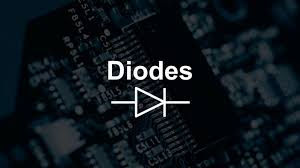In the world of electronics, diodes are fundamental components that play a crucial role in controlling the flow of electrical current. From rectifying AC voltage to protecting circuits from voltage spikes, they are versatile and essential in numerous applications across various industries. In this comprehensive guide, we will explore everything you need to know about diodes: their basic principles, different types, how they work, key applications, advancements in diode technology, and their impact on modern electronics.
What is a Diode?
A diode is a semiconductor device that allows current to flow in one direction while blocking it in the opposite direction. It consists of a semiconductor material, typically silicon or germanium, with two terminals: an anode (positive) and a cathode (negative). The basic function of a diode is to control the direction of current flow, much like a one-way valve controls the flow of water.
How Do Diodes Work?
The operation of a diode is based on the interaction between its semiconductor material and the applied voltage:
- Forward Bias: When a positive voltage is applied to the anode and a negative voltage to the cathode (anode is at a higher potential than the cathode), the diode becomes forward biased. This allows current to flow freely through the diode, with minimal resistance.
- Reverse Bias: When a negative voltage is applied to the anode and a positive voltage to the cathode (anode is at a lower potential than the cathode), the diode becomes reverse biased. In this state, the diode blocks current flow almost entirely, allowing only a small leakage current to pass through.
Types
They come in various types, each designed for specific applications based on their unique characteristics and capabilities:
- Rectifier Diodes: These diodes are used to convert AC (alternating current) to DC (direct current) by allowing current flow in only one direction. They are crucial components in power supply circuits.
- Zener Diodes: Zener diodes operate in reverse breakdown voltage mode, maintaining a stable voltage across their terminals. They are commonly used in voltage regulation and protection circuits.
- Light Emitting Diodes (LEDs): LEDs emit light when current flows through them in the forward direction. They are widely used in displays, indicators, lighting, and optical communications.
- Schottky Diodes: Schottky diodes have a lower forward voltage drop and faster switching speed compared to the standard ones. They are used in high-frequency applications and power rectification.
- Varactor Diodes: Also known as varicap diodes, these are used as voltage-controlled capacitors in tuning circuits and frequency modulation applications.
- Photodiodes: Photodiodes generate a current when exposed to light, making them essential components in optical communication systems, photovoltaic cells, and light sensors.
Applications
Diodes find widespread use in numerous applications across various industries due to their unique electrical properties and reliability:
- Power Supply Rectification: Rectifier diodes convert AC voltage from mains power into DC voltage suitable for electronic devices and circuits.
- Voltage Regulation: Zener diodes are used for voltage regulation and stabilization in power supplies and voltage reference circuits.
- Signal Demodulation: Diodes are used in demodulation circuits to recover the original signal from modulated carrier waves in communication systems.
- Overvoltage Protection: Diodes protect sensitive electronic components from voltage spikes and transient surges by shunting excess current away from the circuit.
- Light Emission: LEDs are used extensively in displays, indicators, automotive lighting, and general illumination due to their efficiency and long lifespan.
Advancements in Diode Technology
Over the years, advancements in semiconductor materials, manufacturing processes, and design techniques have led to significant improvements in diode performance:
- Higher Efficiency: Modern diodes are designed for higher efficiency and lower power consumption, contributing to energy savings in electronic devices and systems.
- Miniaturization: Advances in semiconductor technology have enabled the miniaturization of diodes, allowing for smaller and more compact electronic devices.
- Improved Reliability: Enhanced materials and manufacturing techniques have improved the reliability and longevity of diodes, reducing failure rates and improving overall performance.
- Specialized Applications: Emerging technologies such as silicon carbide (SiC) and gallium nitride (GaN) they offer superior performance in high-power applications, including electric vehicles and renewable energy systems.
The Future of Diodes in Electronics
Looking ahead, diodes will continue to play a crucial role in advancing technology and innovation across various fields:
- Internet of Things (IoT): Diodes will be integral to the proliferation of IoT devices, providing efficient power management and reliable signal processing capabilities.
- 5G Technology: High-frequency diodes will be essential for enabling the high-speed data transmission and low-latency communication required for 5G networks.
- Electric Vehicles (EVs): Advanced diodes will contribute to the development of more efficient and reliable power electronics in EVs, supporting faster charging and longer battery life.
- Renewable Energy: Diodes will play a vital role in the efficient conversion and management of energy in solar panels, wind turbines, and energy storage systems.
Conclusion
In conclusion, diodes are indispensable components in modern electronics, enabling efficient power management, signal processing, and protection across a wide range of applications. From rectifying AC voltage to emitting light and regulating voltage, they serve diverse functions that are essential for the operation of electronic devices and systems. As technology continues to evolve, advancements in diode technology will drive innovation and pave the way for new applications in areas such as IoT, 5G networks, electric vehicles, and renewable energy. Whether you’re a seasoned engineer, electronics enthusiast, or simply curious about the devices you use every day, understanding the role of it is key to appreciating their impact on modern technology and society as a whole. Next time you power up your smartphone, switch on a light, or charge an electric vehicle, take a moment to recognize the silent yet vital contribution of them in making it all possible.













